 Website:
Aesculap®
Website:
Aesculap®
Group: B. Braun Melsungen
Catalog excerpts

ORTHOPAEDIC SURGERY AESCULAP® Excia® 12 / 14 HIP ENDOPROSTHESIS SYS
Open the catalog to page 1
Excia® EXCELLENCE IN ARTHROPLASTY Namur Reims Nancy Avignon Orthez The Excia® Hip System is based on many years of experience with straight stem implants in France, where the first Excia® was implanted in April 2000. Today, the Excia® system is used throughout Europe, the US and Japan. The Excia® system concept of using one instrument set for implantation with or without bone cement is time tested and has been subject to ongoing enhancements. Start Excia® Implantations 2001 – 2004 Excia® Caspar Implantations n Excia® Experience Meeting Lyon n Excia® OrthoPilot® Navigation n FDA Approval in...
Open the catalog to page 2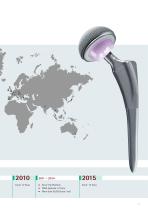
Excia® Hip Platform n SFDA Approval in China n More than 95,000 Excia® sold
Open the catalog to page 3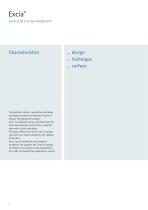
Excia® EXCELLENCE IN ARTHROPLASTY The prosthesis design, implantation technique and implant surface are important factors in primary hip replacement surgery. Excia® is implanted using a rasp that works for both the cementless stem and the cemented stem with a distal centralizer. The lateral offset of the Excia® stem increases with stem size, further enhancing the stability of the joint. Excia® can be implanted with computer navigation and supports less invasive surgical techniques, thus making it well-equipped for the needs of advanced hip replacement surgery. … design … technique …
Open the catalog to page 4
Excia® EXCELLENCE IN ARTHROPLASTY … design The Excia® straight stem is designed for implant longevity with or without bone cement – with standard or high offset. Cementless design Stem design with distal fit and proximal flanges for mechanical stability. Proximal fixation with the Plasmapore® coating. Cemented design Wingless stem design preserves bone near the trochanter. Flanges allow a good proximal fit within the cement mantle. Good stem alignment with the distal centrali
Open the catalog to page 6
Two design options for implantation with or without bone cement with standard or high offset 7
Open the catalog to page 7
Excia® EXCELLENCE IN ARTHROPLASTY … technique Lateral wing Cementless and cemented Excia® stems differ by material, surface and especially by the lateral wing. Rasps The wing rasp is only used in the final step of the cementless implantation. The modular trial necks with standard or high offset offer the possibility to simulate an optimal soft tissue reconstruction. The trial reduction with the stem rasps mimics the final implant accurately
Open the catalog to page 8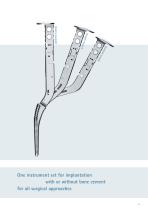
One instrument set for implantation with or without bone cement for all surgical approaches 9
Open the catalog to page 9
Excia® EXCELLENCE IN ARTHROPLASTY Implant surface The cementless Excia features a proximal rough Plasmapore® porous coating. ® The rough 0.35 mm microporous pure titanium coating leads to direct bone apposition in the proximal part of the implant. (1) This is confirmed by longterm clinical experience with various cup and stem implants coated with Plasmapore® since 1987. (1) Simank HG, Stuber M, Frahm R, Helbig L, van Lenthe H, Müller R. The influence of surface coatings of dicalcium phosphate (DCPD) and growth and differentiation factor-5 (GDF-5) on the stability of titanium implants in...
Open the catalog to page 10
Plasmapore® AESCULAP®’s leading surface coating technology with more than 25 years of clinical experience 1
Open the catalog to page 11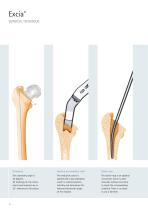
Excia® SURGICAL TECHNIQUE Starter rasp The osteotomy angle is 55 degrees. All markings on the instruments and implants are in 55° reference to this plane. Opening the medullary canal The medullary canal is opened with a box osteotome, which is inserted posterolaterally and determines the femoral anteversion angle of the implant. The starter rasp is an optional instrument which is used manually without any force to check the intramedullary situation. There is no need to use a hammer.
Open the catalog to page 12
Trial Reduction The medullary canal is prepared with increasing sized rasps until the desired depth and stability are achieved. In combination with the Excia® rasp the two modular trial necks with standard (135°) or high offset (128°, + 6 mm) simulate exactly the Excia® implant geometry. The appropriate trial heads enable finally trial reduction and joint inspection with the Excia® rasp.
Open the catalog to page 13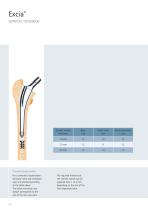
Excia® SURGICAL TECHNIQUE Cement mantle thickness Rasp size Excia® stem size Distal centralizer size Cemented implantation For a cemented implantation the Excia® stem and centralizer sizes are selected according to the table above. The distal centralizer size always corresponds to the size of the last rasp used. The required thickness of the cement mantle can be adjusted from 1 to 2 mm, depending on the size of the final implanted stem.
Open the catalog to page 14
Cementless implantation For a cementless implantation, a groove for Excia®´s lateral wing is incised with the wing profiler, which is guided down a slot in the final stem rasp. The cementless Excia® stem can be implanted after the trial reduction. Biomechanical concept The size of the cementless Excia® stem corresponds directly to the final stem rasp for a proper press-fit. The stem impactor controls the rotational alignment during implantation. Primary stability is achieved by a precise fit of the distal stem and rotational stability in the proximal area. Secondary stability results from...
Open the catalog to page 15
Excia® IMPLANTS Excia® 12/14 cemented Size ISOTAN F * Excia® L (lateralised) implants have an increased offset of 6 mm compared with Excia® standard and a reduced CCD angle of 128° ® Distal centralizer Ceramic modular prosthesis heads Size Metal modular prosthesis heads IMSET Cement plug The materials used in the implant are listed on the packaging. The IMSET plug has the following composition: Gelatine (porcine based), approx. 57 % Glycerol (glycerin), approx. 37 % Water (purified), approx. 6 % Methylparahydroxybenzoate, approx. 0.2 % These components are in compliance with the European...
Open the catalog to page 16
NT330 Excia® 12/14 Basic Set Consisting of: NT329R Tray with supports and small tray for trial components 489 x 253 x 106 mm JH217R Lid TF004 Grafic template Insertion instrument Extraction instrument Wing profiler Modular box osteotome Cross bar for rasp handle Excia® rasps NT308R Rasp size 8 NT309R Rasp size 9 NT310R Rasp size 10 NT311R Rasp size 11 NT312R Rasp size 12 NT313R Rasp size 13 NT314R Rasp size 14 NT315R Rasp size 15 NT316R Rasp size 16 NT317R Rasp size 17 NT318R Rasp size 18 Rasp handles NT001R* Lateral approach, straight NT002R* Posterior approach, straight NT003R* Anterior...
Open the catalog to page 17All Aesculap® catalogs and technical brochures
-
proGAV ® 2.0
36 Pages
-
Targon® FN
36 Pages
-
AESCULAP® NEUROENDOSCOPY
128 Pages
-
AESCULAP® Metha®
28 Pages
-
AESCULAP® BULLDOG CLIPS
8 Pages
-
Quintex®
8 Pages
-
MONOMAX®
16 Pages
-
Premilene® Mesh Plug
8 Pages
-
Aesculap®
16 Pages
-
VascuFlex®
12 Pages
-
Aesculap Aeos®
16 Pages
-
LC – LINEAR CUTTER STAPLER
6 Pages
-
M.blue®
44 Pages
-
Nelson® deluxe
8 Pages
-
CARDIOLOGY
44 Pages
-
Aesculap® Targon® RF
28 Pages
-
Aesculap® OrthoPilot®
52 Pages
-
TrendHip®
16 Pages
-
proSA®
30 Pages
-
activ L®
44 Pages
-
AESCULAP® SINGLE USE PRODUCTS
88 Pages
-
AESCULAP® CoreHip® SYSTEM
36 Pages
-
AdTec® bipolar
8 Pages
-
Aesculap Surgical Instruments
64 Pages
-
EV3.0 CAMERA CONTROL UNIT
12 Pages




































